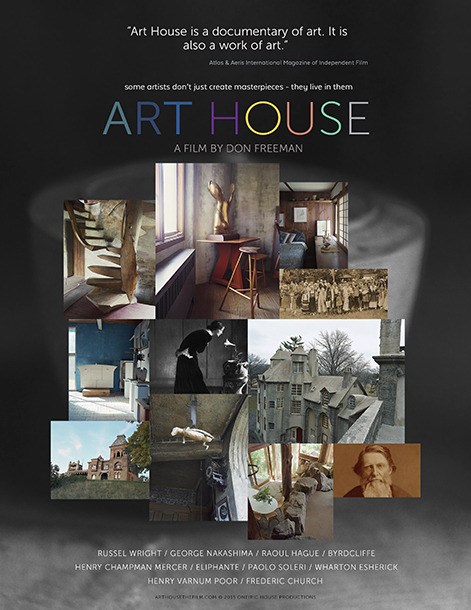This event is now sold out, having received sufficient RSVPs to meet the auditorium’s capacity. A possible second screening has been planned, check www.biartmuseum.org for updates. – BIR Staff
Everybody knows there’s no place like home. Just ask Dorothy.
Or ask Don Freeman, for that matter.
The former Bainbridge Islander-turned-New York-based photographer’s new documentary film “Art House” explores the homes 11 distinguished artists created for and by themselves (mostly). Essentially, each structure is a small piece of the world as they saw it made real.
The project began with a series of photographic essays for various magazines. Freeman’s work has appeared in Vogue, The World of Interiors, Elle Décor and Architectural Digest as well as international galleries, private collections and four books, including “Artists’ Handmade Houses,” the ultimate collection of his work from the original essays on the subject.
“After publication of ‘Artists’ Handmade Houses,’ I returned to make this documentary, interviewing Paolo Soleri and family members and others deeply involved in the care of the houses,” Freeman said. “I came away with anecdotes and insights into their development and their place in the oeuvre of the artists.”
The featured homes range from the castle-like residence of tile designer Henry Chapman Mercer to the surreal desert mega structures of Soleri, a visionary architect whose last filmed interview appears in this motion picture.
The natural extravaganza of waterfalls, gardens and paths created by Twentieth Century designer Russell Wright are explored in conversation with his daughter, as are the studio/homes of sculptor and furniture legend Wharton Esherick; landscape painter Frederic Church; architect and furniture maker George Nakashima; sculptor Raoul Hauge; architect, painter, sculptor and potter Henry Varnum Poor; and sculptor Cosantino Nivola.
Freeman, who lived on Bainbridge from kindergarten to the age of 15, will return to the island for a special free screening of the film, narrated by Alastair Gordon, at 7:30 p.m. Tuesday, Aug. 23 in the Bainbridge Island Museum of Art auditorium.
Freeman said that the dichotomy of his being a first-time filmmaker documenting these custom structures built by artists who were primarily “amateur” architects brought forth many similarities he had not initially anticipated.
“I think it was very similar, my experience making the film to their experiences building a house, because none of us had ever done it before,” he said.
“I think that we get very enamored by technology and what we can achieve with it. This film is very important to look at because it’s a documentation of the opposite of technology.
“There’s so much beauty in something that’s handmade, and to miss those imperfections is missing the point of why it’s so beautiful.
“I don’t know if people know that,” Freeman added.
“I don’t think the millennial people, the students now, realize that these houses are really beautiful because they’re imperfect and they weren’t sketched on a computer.”
As with his still images, Freeman said that the documentary was meant more as a way of conveying how it feels to be in a certain space than it was about the technical craftsmanship that built it.
“My objective was not to document these houses in a way that you would be almost satisfied to see every room,” he said. “It wasn’t really supposed to be a documentation of the houses; it was just supposed to be an inspiration to go and visit yourself or to learn more about that person.”
In fact, Freeman said that through this process his film’s images became a kind of portrait of the artist — sans themselves. A portrait in absentia, wherein the audience “sees” the subject by studying the place they built for themselves to inhabit: their ideal habitat.
In both photography and film, and even more so in architecture, the idea of legacy becomes apparent. What will a particular work mean to the society of the future? What does it mean now?
The fate of many of the houses in the film remains sketchy at best. Even the handful of homes that have been awarded National Historic Landmark status would benefit from conservation efforts that often come at a high price tag, Freeman said.
“I think that every artist should not look at himself as a legacy but look at his work as something that might pop up later in life, like in a show or in a book. Somebody 20 years from now might discovery ‘Art House’ and realize it’s a really valuable documentation of these structures that, I guarantee you, at least three or four of them are not going to survive beyond 10 years.”
Visit www.arthousethefilm.com to learn more about the film or www.donfreemanphoto.com for more information about Freeman’s other works.
This event is now sold out, having received sufficient RSVPs to meet the auditorium’s capacity. A possible second screening has been planned, check www.biartmuseum.org for updates. – BIR Staff


